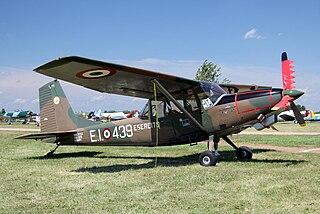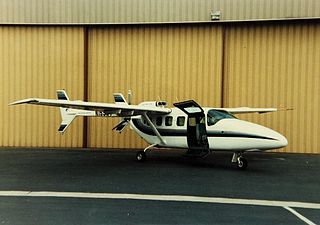Related Research Articles

The Aero Spacelines Super Guppy is a large, wide-bodied cargo aircraft that is used for hauling outsize cargo components. It was the successor to the Pregnant Guppy, the first of the Guppy aircraft produced by Aero Spacelines. Five were built in two variants, both of which were colloquially referred to as the "Super Guppy".

The Handley Page HP.137 Jetstream is a small twin-turboprop airliner, with a pressurised fuselage. The aircraft was designed to meet the requirements of the United States commuter and regional airline market. The design was later improved and built by British Aerospace as the BAe Jetstream 31 and BAe Jetstream 32, featuring different turboprop engines.

The Cessna Skymaster is an American twin-engine civil utility aircraft built in a push-pull configuration. Its engines are mounted in the nose and rear of its pod-style fuselage. Twin booms extend aft of the wings to the vertical stabilizers, with the rear engine between them. The horizontal stabilizer is aft of the pusher propeller, mounted between and connecting the two booms. The combined tractor and pusher engines produce centerline thrust and a unique sound. The Cessna O-2 Skymaster is a military version of the Cessna Model 337 Super Skymaster.

The Dornier 228 is a twin-turboprop STOL utility aircraft, designed and first manufactured by Dornier GmbH from 1981 until 1998. Two hundred and forty-five were built in Oberpfaffenhofen, Germany. In 1983, Hindustan Aeronautics Limited (HAL) bought a production licence and manufactured another 125 aircraft in Kanpur, Uttar Pradesh, India. In July 2017, 63 aircraft were still in airline service.

The Cessna 441 Conquest II is the first turboprop powered aircraft designed by Cessna and was meant to fill the gap between their jets and piston-engined aircraft. It was developed in November 1974, with the first aircraft delivered in September 1977. It is a pressurized, 8–9 passenger turbine development of the Cessna 404 Titan. The ICAO designator as used in flight plans is C441.

The Fletcher FU-24 is an agricultural aircraft made in New Zealand. Being one of the first aircraft designed for aerial topdressing, the Fletcher has also been used for other aerial applications as a utility aircraft, and for sky diving.

The Canadair CL-66 was a turboprop version of the civilian Convair CV-440 Metropolitan. The CC-109 Cosmopolitan or "Cosmo" in RCAF service became the standard VIP aircraft as well as replacing the Douglas Dakota and the North American B-25 Mitchell in light transport duties. After a lengthy career stretching into the 1990s, the CC-109 was replaced by the CC-142 Dash 8 and CC-144 Challenger.

The Honeywell TPE331 is a turboprop engine. It was designed in the 1950s by Garrett AiResearch, and produced since 1999 by successor Honeywell Aerospace. The engine's power output ranges from 575 to 1,650 shaft horsepower.
The Conair Firecat is a fire-fighting aircraft developed in Canada in the 1970s by modifying military surplus Grumman S-2 Trackers. The modifications were developed by the maintenance arm of the Conair Group, which became a separate company called Cascade Aerospace.
The Valmet L-80 TP Turbo-Vinha was a prototype for a new Finnish turboprop basic trainer aircraft. The aircraft, which carried the registration OH-VBB, first flew on 12 February 1985. It was destroyed in a crash on 24 April 1985, during its 14th flight, killing the test pilot Paavo Janhunen. The aircraft was a further development of the Valmet L-70 Vinka and would eventually lead to the Valmet L-90 Redigo.

The Swearingen Merlin or the Fairchild Aerospace Merlin is a pressurized, twin turboprop business aircraft first produced by Swearingen Aircraft, and later by Fairchild at a plant in San Antonio, Texas.

The Beechcraft Model 38P Lightning was an experimental turboprop aircraft built and tested by Beechcraft in the 1980s.

The SIAI-Marchetti SM.1019 is an Italian STOL liaison monoplane built by SIAI-Marchetti for the Italian Army. It is a turboprop-powered derivative of the Cessna O-1 Bird Dog.

The Vulcanair SF.600 Canguro was a feederliner developed in Italy in the late 1970s. Despite a number of attempts to put the aircraft into series production, only a small number were ever built. The Canguro was a high-wing cantilever monoplane of conventional configuration with a fuselage of rectangular cross-section and a high-set tail. The tricycle undercarriage was not retractable, and its main units were carried on sponsons on the fuselage sides. SIAI Marchetti provided funding towards the construction of the prototype, and constructed this aircraft at the former Aviamilano plant. After flight testing proved positive, the type was put on sale, but failed to attract buyers in any number, even when the original piston engines were exchanged for turboprops and retractable undercarriage was offered as an option.

The Conroy Tri-Turbo-Three was a Douglas DC-3 fitted with three Pratt & Whitney Canada PT6A turboprop engines by Conroy Aircraft; the third engine was mounted on the nose of the aircraft.

The Basler Turbo 37/Spectrum SA-550 is a twin-boom single engined aircraft converted from a Reims/Cessna FTB337G Skymaster by Basler Turbo Conversions and Spectrum Aircraft Corporation. The aircraft first flew on 1 February 1983.

The Short SC.7 Skyvan is a British 19-seat twin-turboprop aircraft first flown in 1963, that was manufactured by Short Brothers of Belfast, Northern Ireland. Featuring a basic rugged design and STOL capabilities, it was used in small numbers by airlines, and also by some smaller air forces. In more recent years the remaining examples were mostly used for short-haul freight and skydiving.

The Evektor EV-55 Outback is a twin-engine turboprop aircraft designed and built in the Czech Republic by Evektor-Aerotechnik. The prototype first flew on 24 June 2011. The project's development was suspended in March 2017.

The Performance Turbine Legend is an American sports monoplane designed by Performance Aircraft for sale as a kit for amateur construction.

The Diamond DART is a series of tandem, two-seat civilian and military turboprop trainers manufactured by Austrian Diamond Aircraft, "DART" meaning Diamond Aircraft Reconnaissance Trainer.
References
- ↑ Goleta Air and Space Museum (n.d.). "Stolifter" . Retrieved 2009-11-24.
{{cite web}}: CS1 maint: year (link) - 1 2 3 Flight International (November 1968). "Conroy Flies Stolifter" . Retrieved 2009-12-14.
- ↑ Federal Aviation Administration (14 March 2023). "FAA Registry - N-Number Inquiry Result N1414C" . Retrieved 14 March 2023.